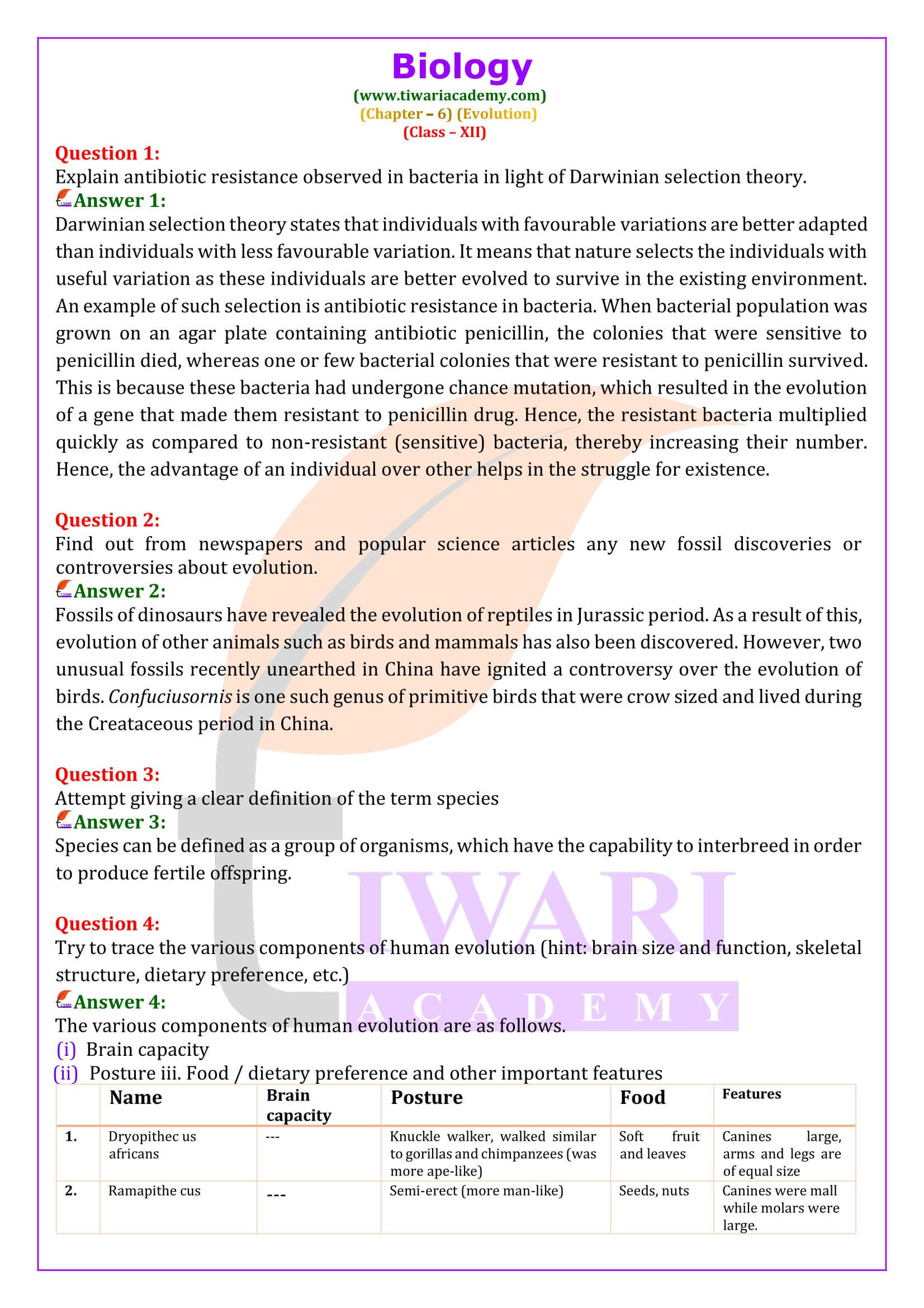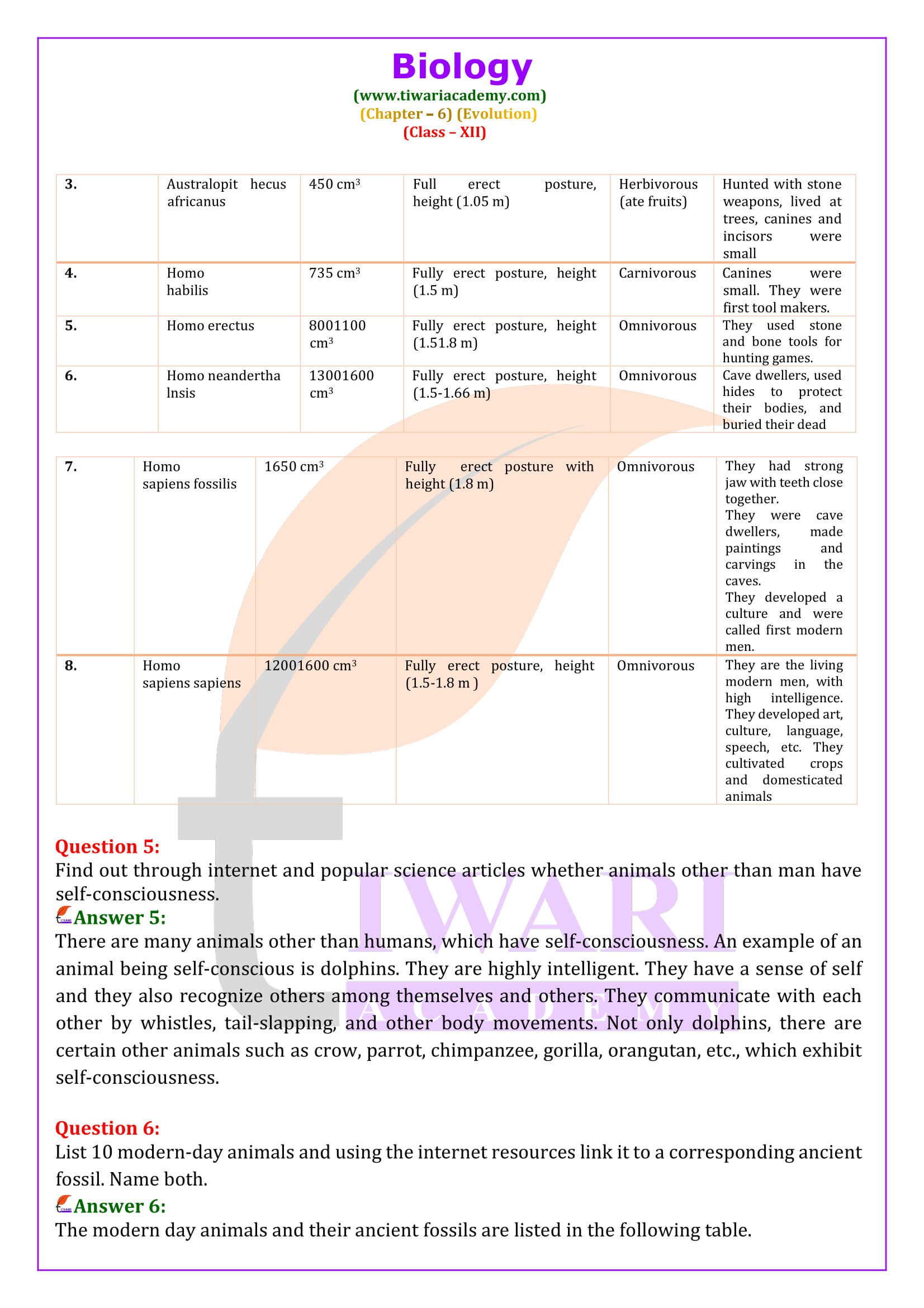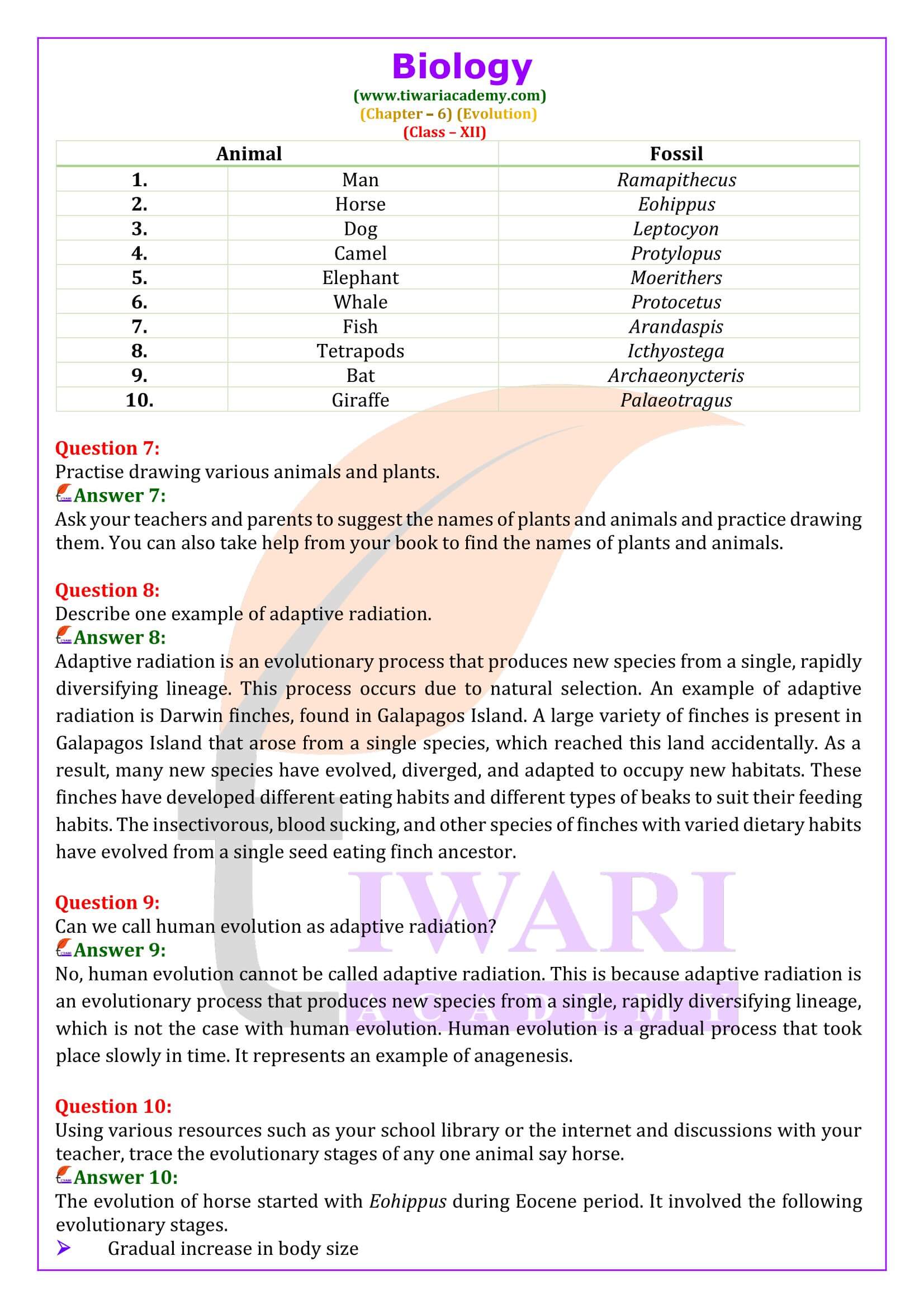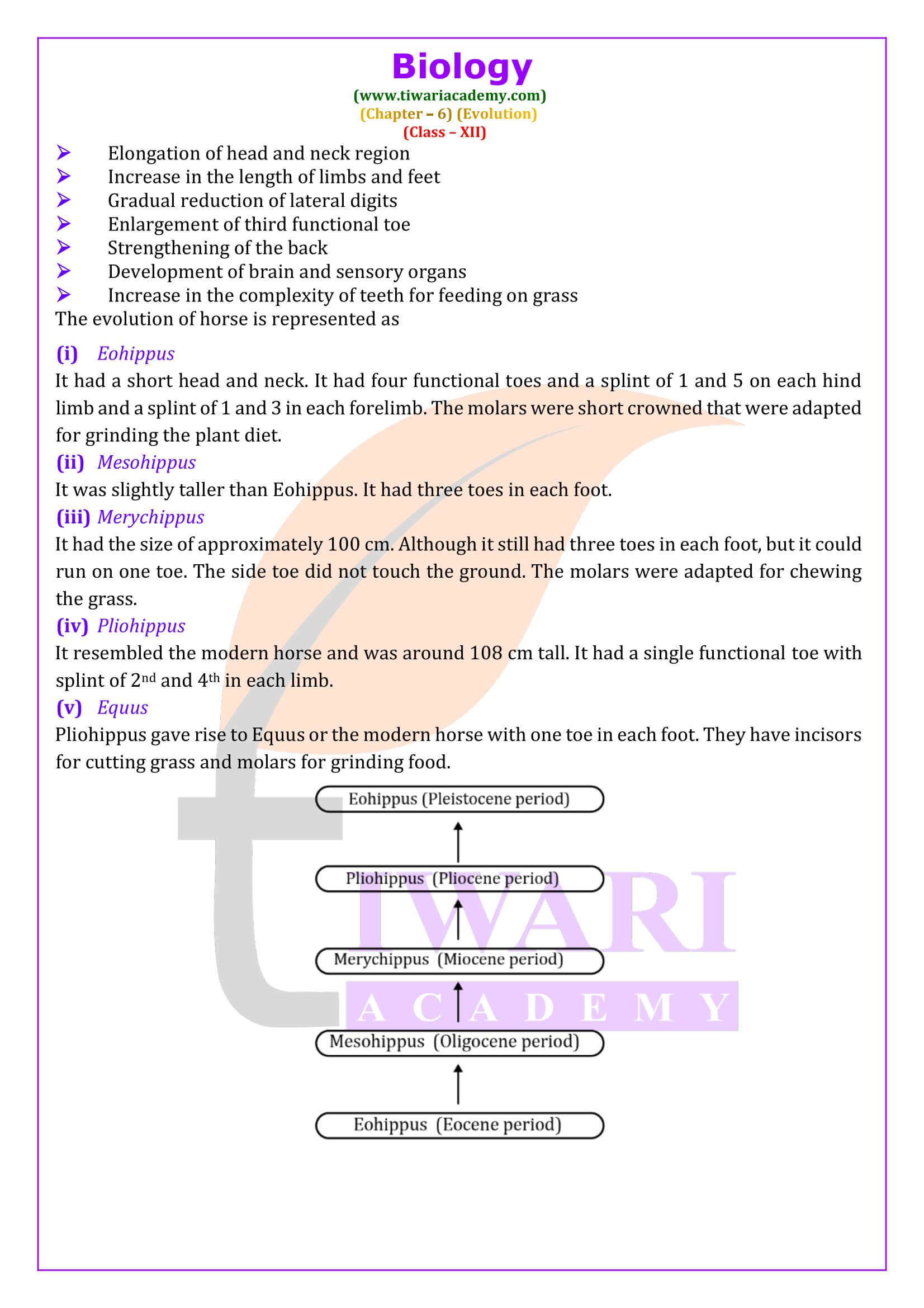NCERT Solutions for Class 12 Biology Chapter 6 Evolution in Hindi and English medium to Study Online in PDF format updated for new session 2025-26 for UP Board, MP Board, CBSE, Gujrat Board and other boards who are following CBSE.
NCERT Solutions for Class 12 Biology Chapter 6
NCERT Solutions 2025-26 for other subjects based on latest CBSE Syllabus 2025-26 is also given to download. Download Offline Apps and Share Your Questions with us through Discussion Forum.
| Class: 12 | Science |
| Subject: | Biology |
| Chapter 6: | Evolution |
| Content: | NCERT solutions and Extra Questions |
| Academic Session: | 2025-26 |
| Medium: | Hindi and English Medium |
Class 12 Biology Chapter 6 Solutions in English
NCERT Solutions for Class 12 Biology Chapter 6 Evolution is given below to free download in PDF form for academic year 2025-26. NCERT Solutions are applicable for UP Board, CBSE, Gujrat, MP Board and all other boards who are using NCERT Books and following CBSE Syllabus.
Important Terms related to Chapter 6
1. Artificial Selection: It is the process carried out by man to select better breeds of plants and animals.
2. Founders Effect: A genetic drift in human population where a population in a new settlement have different gene frequency from that of the parent population. The original drifted population said to be founder.
3. Gene Pool: Sum total of all the genes in a population.
4. Genetic Drift: Chance elimination of genes of certain traits from a population due to migration or death.
5. Saltation: Single step large mutations.
6. Speciation: It is the formation of new species from the pre-existing ones.
7. Organic (Biological) Evolution: Changes at the characteristics/features of organisms or groups of such population over a number of generations.
8. Homologous organs: These have same basic structure and embryonic origin but perform different functions in different species.
The Theories of Origin of Life
1. Theory of Special Creation: According to this theory God has created life within 6 days.
2. Theory of Spontaneous Generation: According to this theory life originated from decaying and rotting matter like straw and mud.
3. Panspermiatic Theory: According to this theory life came from space in the form of spores called Panspermia.
4. Modern Theory or Oparin-Haldane Theory: According to this theory life originated upon earth spontaneously from non-living matter. First inorganic compounds then organic compounds were formed in accordance with ever changing environment conditions. This is called chemical evolution. The conditions on earth were high temperature, volcanic storms, reducing atmosphere (without free oxygen) containing methane and ammonia.
Evolution of Man
1. About 15 mya, primates called Dryopithecus and Ramapitheus were existing.
2. Dryopithecus: Were more ape-like, live in Asia, Africa and Europe. Walk semierect, Hand & Skull were monkey like.
3. Ramapithecus: First man-like, walk straight on legs, not taller than 4 feet.
4. Australopithecines: 2 mya, lived in east african grassland, hunted with stones, ate fruits, Teeth larger.
5. Homo habilis: 2 mya, brain capacity 650-800cc, did not eat meat, dentition like humans.
6. Homo erectus: 1.5 mya, brain capacity 900cc, ate meat, walk erect.
7. Homo sapiens: 5 lakhs years ago, in Africa, and spread to all parts of world.
8. Neanderthal man: 40,000-1,00,000 years ago, brain capacity 1400cc, broad forehead, lives in caves, use hides to protect their bodies.
Attempt giving a clear definition of the term species.
Species can be defined as a group of organisms, which have the capability to interbreed in order to produce fertile offspring.
Important Questions on 12th Biology Chapter 6
Explain antibiotic resistance observed in bacteria in light of Darwinian selection theory.
Darwinian selection theory states that individuals with favourable variations are better adapted than individuals with less favourable variation. It means that nature selects the individuals with useful variation as these individuals are better evolved to survive in the existing environment. An example of such selection is antibiotic resistance in bacteria. When bacterial population was grown on an agar plate containing antibiotic penicillin, the colonies that were sensitive to penicillin died, whereas one or few bacterial colonies that were resistant to penicillin survived. This is because these bacteria had undergone chance mutation, which resulted in the evolution of a gene that made them resistant to penicillin drug. Hence, the resistant bacteria multiplied quickly as compared to non-resistant (sensitive) bacteria, thereby increasing their number. Hence, the advantage of an individual over other helps in the struggle for existence.
Find out from newspapers and popular science articles any new fossil discoveries or controversies about evolution.
Fossils of dinosaurs have revealed the evolution of reptiles in Jurassic period. As a result of this, evolution of other animals such as birds and mammals has also been discovered. However, two unusual fossils recently unearthed in China have ignited a controversy over the evolution of birds. Confuciusornis is one such genus of primitive birds that were crow sized and lived during the Creataceous period in China.
Find out through internet and popular science articles whether animals other than man have self-consciousness.
There are many animals other than humans, which have self-consciousness. An example of an animal being self-conscious is dolphins. They are highly intelligent. They have a sense of self and they also recognize others among themselves and others. They communicate with each other by whistles, tail-slapping, and other body movements. Not only dolphins, there are certain other animals such as crow, parrot, chimpanzee, gorilla, orangutan, etc., which exhibit self-consciousness.
Describe one example of adaptive radiation.
Adaptive radiation is an evolutionary process that produces new species from a single, rapidly diversifying lineage. This process occurs due to natural selection. An example of adaptive radiation is Darwin finches, found in Galapagos Island. A large variety of finches is present in Galapagos Island that arose from a single species, which reached this land accidentally. As a result, many new species have evolved, diverged, and adapted to occupy new habitats. These finches have developed different eating habits and different types of beaks to suit their feeding habits. The insectivorous, blood sucking, and other species of finches with varied dietary habits have evolved from a single seed eating finch ancestor.
Can we call human evolution as adaptive radiation?
No, human evolution cannot be called adaptive radiation. This is because adaptive radiation is an evolutionary process that produces new species from a single, rapidly diversifying lineage, which is not the case with human evolution. Human evolution is a gradual process that took place slowly in time. It represents an example of anagenesis.







